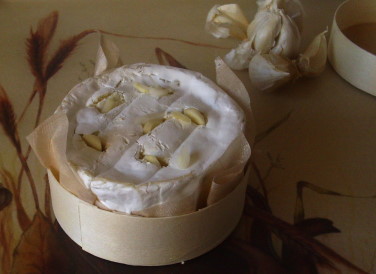Box-Baked Soft Cheese
By Mike on Thursday, July 16, 2009, 13:34 - Permalink
 This is a meal based on really simple preparation of a few quite modest components, yet the result is an eating experience that seems truly luxurious.
This is a meal based on really simple preparation of a few quite modest components, yet the result is an eating experience that seems truly luxurious.
Preparation
To make it, you need any ripe, soft, unwaxed cheese with a rind - Brie or Camembert are the usual choices, but it will work with almost any other cheese of that general type, including the ones with blue in them.
What is reasonably important is the box - because this dish is cooked in the box. I suppose it would work just as well in a dish or ramekin, if one can be found of the right size for your cheese.
Method:
Remove the cheese (in this picture, a wedge of Brie) from the box and unwrap it completely - no paper or plastic wrapping should remain. Remove, as far as possible, any stickers or labels from the box.
Place a sheet of baking parchment or silicone paper over the box and drop the cheese back in.
preheat your oven to about 150C (300F or Gas Mark 2)
 Slice up a clove of fresh garlic, stab slits in the top surface of the cheese (in this picture, a West Country Camembert) and push the garlic slivers down into the holes. If you like your garlic a bit milder, just cut the clove in half and rub it over the top of the cheese.
Slice up a clove of fresh garlic, stab slits in the top surface of the cheese (in this picture, a West Country Camembert) and push the garlic slivers down into the holes. If you like your garlic a bit milder, just cut the clove in half and rub it over the top of the cheese.
Splash a couple of tablespoons of white wine or good cider over the top of the cheese, ideally letting some of it run into the holes.
Place the boxed cheese on a baking tray and bake in the oven for 5 to 10 minutes - until the top starts to crack and ooze.
While the cheese is baking, cut up some chunks of crusty bread and some pieces of ripe fruit - I used peaches, apples and grapes here, but apricots, pears or figs are also great.
Serve the cheese immediately while it's still hot - tear of pieces of bread and dip them into the melted inside of the cheese - it's all edible, including the rind (but not the paper, or the box, obviously).
A glass or two of the remaining wine or cider is nice to accompany this meal. There's no real way to eat this without getting in a sticky, cheesy mess, but that's just part of the fun.
Boxing Clever
The box isn't just a gimmick for this recipe - it's necessary to stop the already soft cheese from just melting and going everywhere - the best kind of box is the traditional kind made from thin strips of wood, secured together with metal staples.
The Camembert I bought (pictured left) was in a box held together by glue - which melted in the oven and allowed the box to spring apart - fortunately in that case, the cheese was a little under-ripe when I started and so it didn't sag too much until I got it on the plate.
Picking A Ripe Cheese
Soft cheeses such as Brie and Camembert are not pressed to remove all the whey (as are hard cheeses such as Cheddar) - because of this, they start off reasonably firm and they ripen, becoming progressively softer, even runny and often a bit smelly too.
Ripe cheeses can be identified in the shop by pressing gently in the middle of the top surface - there should be a soft, springy 'give'. Unripe cheeses will feel hard or stiff when pressed gently.
